SLLSE15A July 2011 – November 2015 SN65LVDS4
PRODUCTION DATA.
- 1 Features
- 2 Applications
- 3 Description
- 4 Revision History
- 5 Pin Configuration and Functions
-
6 Specifications
- 6.1 Absolute Maximum Ratings
- 6.2 ESD Ratings
- 6.3 Recommended Operating Conditions
- 6.4 Thermal Information
- 6.5 Receiver Electrical Characteristics: VCC = 2.5 V
- 6.6 Receiver Electrical Characteristics: VCC = 1.8 V
- 6.7 Receiver Switching Characteristics: VCC = 2.5 V
- 6.8 Receiver Switching Characteristics: VCC = 1.8 V
- 6.9 Typical Characteristics
- 7 Parameter Measurement Information
- 8 Detailed Description
- 9 Application and Implementation
- 10Power Supply Recommendations
- 11Layout
- 12Device and Documentation Support
- 13Mechanical, Packaging, and Orderable Information
Package Options
Mechanical Data (Package|Pins)
- RSE|10
Thermal pad, mechanical data (Package|Pins)
Orderable Information
6 Specifications
6.1 Absolute Maximum Ratings
over operating free-air temperature range (unless otherwise noted)(1)| MIN | MAX | UNIT | ||
|---|---|---|---|---|
| Supply voltage range, VCC (2) | –0.5 | 4 | V | |
| Receiver output voltage logic level and driver input voltage logic level supply, VDD | –0.5 | 4 | V | |
| Input voltage range, VI | (A or B) | –0.5 | VCC + 0.3 | V |
| Output voltage, VO | (R) | –0.5 | VDD + 0.3 | V |
| Differential input voltage magnitude, |VID| | 1 | V | ||
| Receiver output current, IO | –12 | 12 | mA | |
| Continuous total power dissipation, PD | See Thermal Information | |||
| Storage temperature (non operating) | –65 | 150 | °C | |
(1) Stresses beyond those listed under Absolute Maximum Ratings may cause permanent damage to the device. These are stress ratings only, and functional operation of the device at these or any other conditions beyond those indicated under Recommended Operating Conditions is not implied. Exposure to absolute-maximum-rated conditions for extended periods may affect device reliability.
(2) All voltage values, except differential I/O bus voltages, are with respect to network ground terminal.
6.2 ESD Ratings
| VALUE | UNIT | ||||
|---|---|---|---|---|---|
| V(ESD) | Electrostatic discharge | Human body model (HBM), per ANSI/ESDA/JEDEC JS-001(1) | All pins | 2000 | V |
| Bus pins (A, B, Y, Z) | 2000 | ||||
| Charged-device model (CDM), per JEDEC specification JESD22-C101(2) | 500 | ||||
(1) JEDEC document JEP155 states that 500-V HBM allows safe manufacturing with a standard ESD control process.
(2) JEDEC document JEP157 states that 250-V CDM allows safe manufacturing with a standard ESD control process.
6.3 Recommended Operating Conditions
| MIN | NOM | MAX | UNIT | ||
|---|---|---|---|---|---|
| VCC1.8 | Core supply voltage | 1.62 | 1.8 | 1.98 | V |
| VCC2.5 | Core supply voltage | 2.25 | 2.5 | 2.75 | V |
| VDD1.8 | Output drive voltage | 1.62 | 1.8 | 1.98 | V |
| VDD2.5 | Output drive voltage | 2.25 | 2.5 | 2.75 | V |
| VDD3.3 | Output drive voltage | 3 | 3.3 | 3.6 | V |
| TA | Operating free-air temperature | –40 | 85 | °C | |
| |VID| | Magnitude of differential input voltage | 0.15 | 0.6 | V | |
| fop | Operating frequency range | 10 | 250 | MHz | |
| |VINMAX| | Input voltage (any combination of input or common-mode voltage) See (1)Maximum Input Voltage, VIN(max). | 0 | VCC | V | |
(1) Any combination of input or common-mode voltage should not be below 0 V or above VCC.
6.4 Thermal Information
| THERMAL METRIC(1) | SN65LVDS4 | UNIT | |
|---|---|---|---|
| RSE (UQFN) | |||
| 10 PINS | |||
| RθJA | Junction-to-ambient thermal resistance | 171.2 | °C/W |
| RθJC(top) | Junction-to-case (top) thermal resistance | 60.7 | °C/W |
| RθJB | Junction-to-board thermal resistance | 71.4 | °C/W |
| ψJT | Junction-to-top characterization parameter | 0.8 | °C/W |
| ψJB | Junction-to-board characterization parameter | 64.7 | °C/W |
(1) For more information about traditional and new thermal metrics, see the Semiconductor and IC Package Thermal Metrics application report, SPRA953.
6.5 Receiver Electrical Characteristics: VCC = 2.5 V
over recommended operating conditions, VCC = 2.5 V, VID = 150 mV–600 mV, VCM = VID/2 to VCC – VID/2 V, 10 pF load (unless otherwise noted)| PARAMETER | TEST CONDITIONS | MIN(2) | TYP(1) | MAX | UNIT | ||
|---|---|---|---|---|---|---|---|
| VITH+ | Positive-going differential input voltage threshold | See Figure 17, VCC1.8 , VCC2.5 | 50 | mV | |||
| VITH– | Negative-going differential input voltage threshold | See Figure 17, VCC1.8 , VCC2.5 | –50 | mV | |||
| VOH | High-level output voltage | VDD = 3.3 V, IOH = –8 mA | VDD – 0.25 | V | |||
| VDD = 2.5 V, IOH = –6 mA | VDD – 0.25 | ||||||
| VDD = 1.8 V, IOH = –4 mA | VDD – 0.25 | ||||||
| VOL | Low-level output voltage | VDD = 3.3 V, IOL = 8 mA | 0.25 | V | |||
| VDD = 2.5 V, IOL = 6 mA | 0.25 | ||||||
| VDD = 1.8 V, IOL = 4 mA | 0.25 | ||||||
| Pstatic | Static power | No load, steady state, VDD = 3.3 V, VID+ | 22 | 28 | mW | ||
| No load, steady state, VDD = 2.5 V, VID+ | 20 | 25 | |||||
| CI | Input capacitance | VI = 0.4 sin(4E6πt) + 0.5 V | 4 | pF | |||
| CO | Output capacitance | VI = 0.4 sin(4E6πt) + 0.5 V | 4 | pF | |||
(1) All typical values are at 25°C .
(2) The algebraic convention, in which the least positive (most negative) limit is designated as a minimum, is used in this data sheet.
6.6 Receiver Electrical Characteristics: VCC = 1.8 V
over recommended operating conditions, VCC = 1.8 V, VID = 150 mV–600 mV, VCM = VID/2 to VCC – VID/2 V, 10 pF load (unless otherwise noted)| PARAMETER | TEST CONDITIONS | MIN(2) | TYP(1) | MAX | UNIT | ||
|---|---|---|---|---|---|---|---|
| VITH+ | Positive-going differential input voltage threshold | See Figure 17, VCC1.8 , VCC2.5 | 50 | mV | |||
| VITH– | Negative-going differential input voltage threshold | See Figure 17, VCC1.8 , VCC2.5 | –50 | mV | |||
| VOH | High-level output voltage | VDD = 3.3 V, IOH = –8 mA | VDD – 0.25 | V | |||
| VDD = 2.5 V, IOH = –6 mA | VDD – 0.25 | ||||||
| VDD = 1.8 V, IOH = –4 mA | VDD – 0.25 | ||||||
| VOL | Low-level output voltage | VDD = 3.3 V, IOL = 8 mA | 0.25 | V | |||
| VDD = 2.5 V, IOL = 6 mA | 0.25 | ||||||
| VDD = 1.8 V, IOL = 4 mA | 0.25 | ||||||
| Pstatic | Static power | No load, steady state, VDD = 3.3 V, VID+ | 18 | 21 | mW | ||
| No load, steady state, VDD = 2.5 V, VID+ | 16 | 19 | |||||
| No load, steady state, VDD = 1.8 V, VID+ | 13 | 16 | |||||
| CI | Input capacitance | VI = 0.4 sin(4E6πt) + 0.5 V | 4 | pF | |||
| CO | Output capacitance | VI = 0.4 sin(4E6πt) + 0.5 V | 4 | pF | |||
6.7 Receiver Switching Characteristics: VCC = 2.5 V
over recommended operating conditions, VCC = 2.5 V, VID = 150 mV–600 mV, VCM = VID/2 to VCC – VID/2 V, 10 pF load (unless otherwise noted)| PARAMETER | TEST CONDITIONS | MIN | TYP(1) | MAX | UNIT | ||
|---|---|---|---|---|---|---|---|
| tPLH | Propagation delay time, low-to-high-level output | CL = 10 pF, See Figure 19 |
2.5 | 3.3 | ns | ||
| tPHL | Propagation delay time, high-to-low-level output | 2.5 | 3.3 | ns | |||
| tsk(p) | Pulse skew (|tpHL – tpLH|)(2) | 240 | ps | ||||
| tr | Output signal rise time | VDD = 3.3 V | 550 | ps | |||
| VDD = 2.5 V | 600 | ||||||
| tf | Output signal fall time | VDD = 3.3 V | 550 | ps | |||
| VDD = 2.5 V | 600 | ||||||
| tjit | Residual jitter added | Carrier frequency = 122.8 MHz, input signal amplitude = 500 mVpp sine wave, integration bandwidth for rms jitter = 20 khz-20 MHz, VDD = 2.5 V | 370 | fs | |||
(1) All typical values are at 25°C.
(2) tsk(p) is the magnitude of the time difference between the high-to-low and low-to-high propagation delay times at an output.
6.8 Receiver Switching Characteristics: VCC = 1.8 V
over recommended operating conditions, VCC = 1.8 V, VID = 150 mV–600 mV, VCM = VID/2 to VCC – VID/2 V, 10 pF load (unless otherwise noted)| PARAMETER | TEST CONDITIONS | MIN | TYP(1) | MAX | UNIT | ||
|---|---|---|---|---|---|---|---|
| tPLH | Propagation delay time, low-to-high-level output | CL = 10 pF, See Figure 19 |
3.2 | 3.8 | ns | ||
| tPHL | Propagation delay time, high-to-low-level output | 3.2 | 3.8 | ns | |||
| tsk(p) | Pulse skew (|tpHL – tpLH|)(2) | 240 | ps | ||||
| tr | Output signal rise time | VDD = 3.3 V | 550 | ps | |||
| VDD = 2.5 V | 600 | ||||||
| VDD = 1.8 V | 750 | ||||||
| tf | Output signal fall time | VDD = 3.3 V | 550 | ps | |||
| VDD = 2.5 V | 600 | ||||||
| VDD = 1.8 V | 750 | ||||||
| tjit | Residual jitter added | Carrier frequency = 122.8 MHz, input signal amplitude = 500 mVpp sine wave, integration bandwidth for rms jitter = 20 khz-20 MHz, VDD = 1.8 V | 370 | fs | |||
6.9 Typical Characteristics
VICM = 1.2 V, VID = 300 mV, CL = 10 pF, input rise time and fall time = 1 ns, input frequency = 250 MHz, 50% duty cycle, TA = 25°C, unless otherwise noted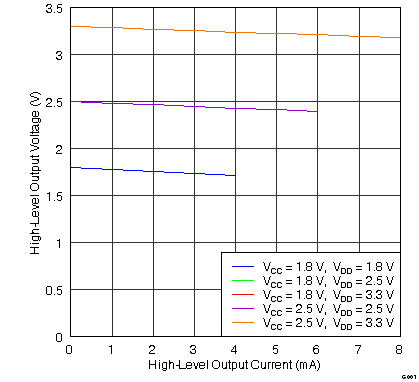 Figure 1. High-Level Output Voltage vs. High-Level Output Current
Figure 1. High-Level Output Voltage vs. High-Level Output Current
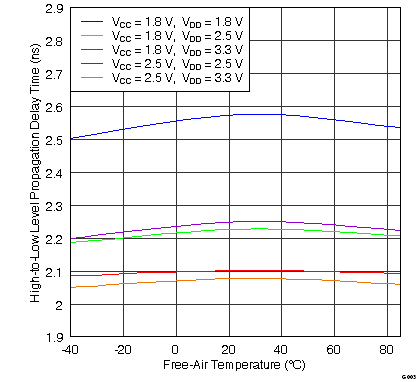 Figure 3. High- to Low-Level Propagation Delay Time vs. Free-Air Temperature
Figure 3. High- to Low-Level Propagation Delay Time vs. Free-Air Temperature
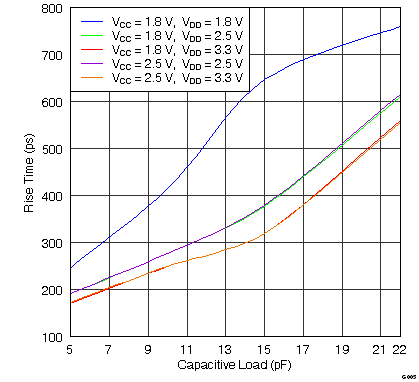 Figure 5. Rise Time vs. Capacitive Load
Figure 5. Rise Time vs. Capacitive Load
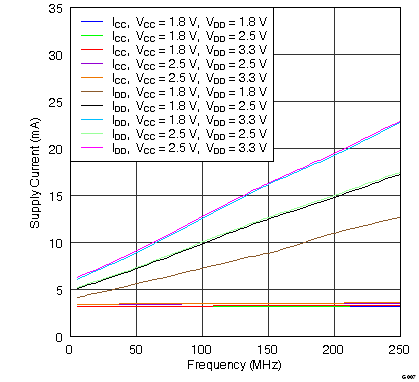 Figure 7. Supply Current vs. Frequency
Figure 7. Supply Current vs. Frequency
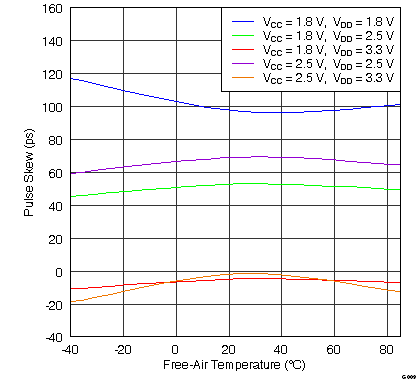 Figure 9. Pulse Skew vs. Temperature
Figure 9. Pulse Skew vs. Temperature
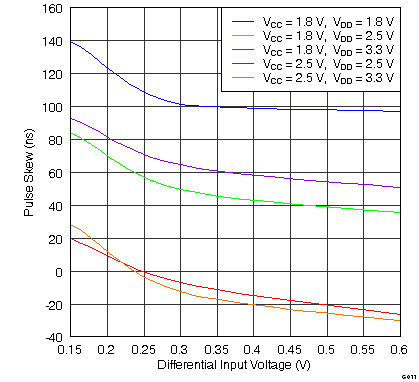 Figure 11. Pulse Skew vs. Differential Input Voltage
Figure 11. Pulse Skew vs. Differential Input Voltage
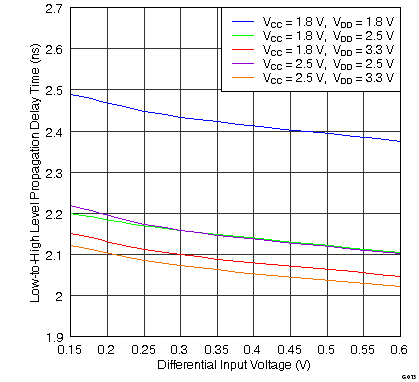 Figure 13. Propagation Delay, Low-to-High vs. Differential Input Voltage
Figure 13. Propagation Delay, Low-to-High vs. Differential Input Voltage
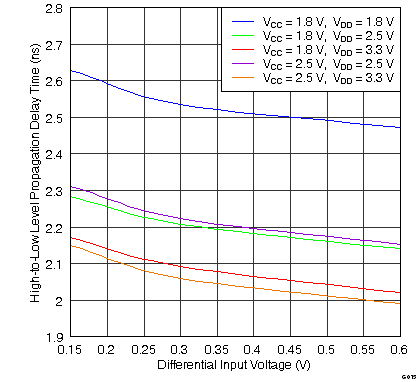 Figure 15. Propagation Delay, High-to-Low vs. Differential Input Voltage
Figure 15. Propagation Delay, High-to-Low vs. Differential Input Voltage
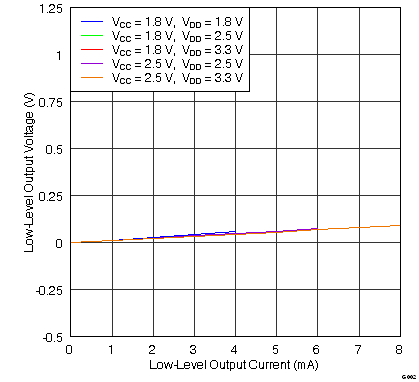 Figure 2. Low-Level Output Voltage vs. Low-Level Output Current
Figure 2. Low-Level Output Voltage vs. Low-Level Output Current
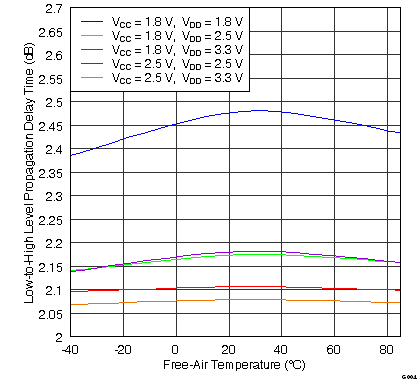 Figure 4. Low- to High-Level Propagation Delay Time vs. Free-Air Temperature
Figure 4. Low- to High-Level Propagation Delay Time vs. Free-Air Temperature
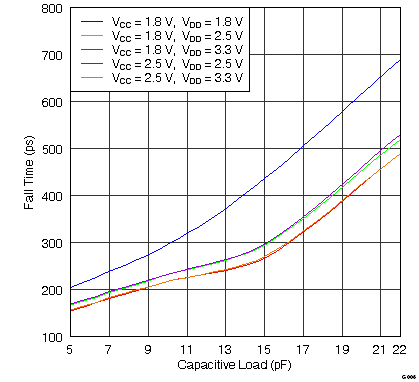 Figure 6. Fall Time vs. Capacitive Load
Figure 6. Fall Time vs. Capacitive Load
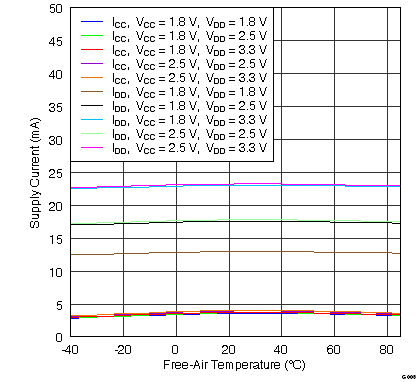 Figure 8. Supply Current vs. Temperature
Figure 8. Supply Current vs. Temperature
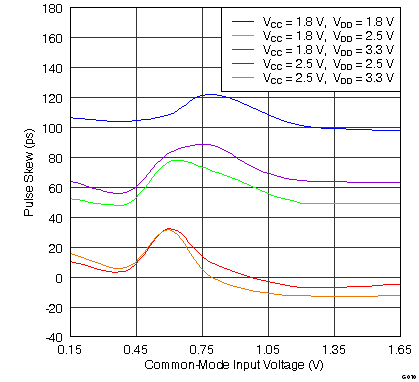 Figure 10. Pulse Skew vs. Common-Mode Voltage
Figure 10. Pulse Skew vs. Common-Mode Voltage
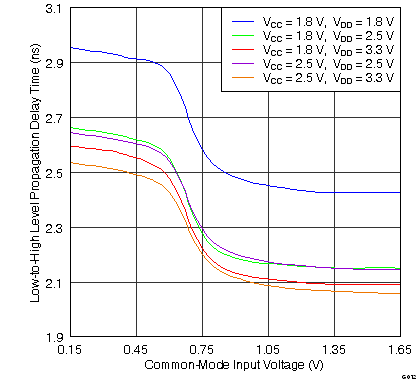 Figure 12. Propagation Delay, Low-to-High vs. Common-Mode Voltage
Figure 12. Propagation Delay, Low-to-High vs. Common-Mode Voltage
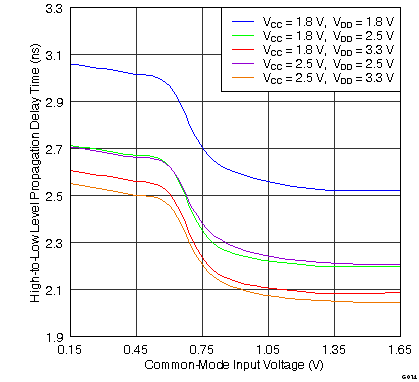 Figure 14. Propagation Delay, High-to-Low vs. Common-Mode Voltage
Figure 14. Propagation Delay, High-to-Low vs. Common-Mode Voltage
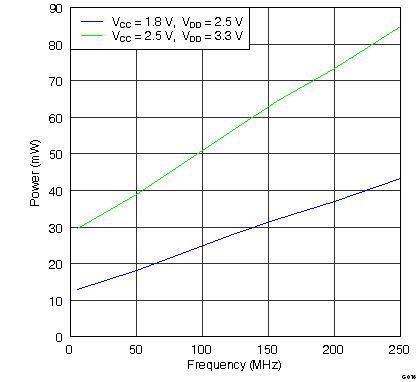 Figure 16. Power vs. Frequency
Figure 16. Power vs. Frequency